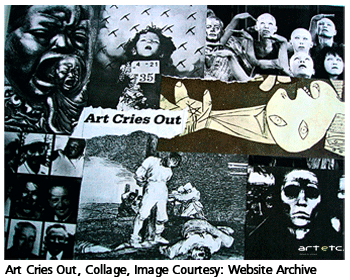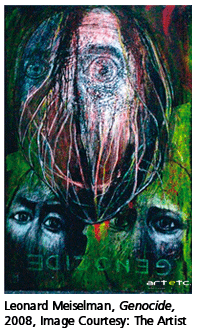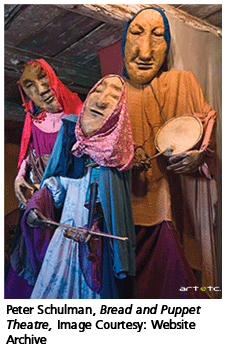- Publisher's Note
- Editorial
- Guerrilla Girls: The Masked Culture Jammers of the Art World
- Creating for Change: Creative Transformations in Willie Bester’s Art
- Radioactivists -The Mass Protest Through the Lens
- Broot Force
- Reza Aramesh: Action X, Denouncing!
- Revisiting Art Against Terrorism
- Outlining the Language of Dissent
- In the Summer of 1947
- Mapping the Conscience...
- 40s and Now: The Legacy of Protest in the Art of Bengal
- Two Poems
- The 'Best' Beast
- May 1968
- Transgressive Art as a Form of Protest
- Protest Art in China
- Provoke and Provoked: Ai Weiwei
- Personalities and Protest Art
- Occupy, Decolonize, Liberate, Unoccupy: Day 187
- Art Cries Out: The Website and Implications of Protest Art Across the World
- Reflections in the Magic Mirror: Andy Warhol and the American Dream
- Helmut Herzfeld: Photomontage Speaking the Language of Protests!
- When Protest Erupts into Imagery
- Ramkinkar Baij: An Indian Modernist from Bengal Revisited
- Searching and Finding Newer Frontiers
- Violence-Double Spread: From Private to the Public to the 'Life Systems'
- The Virasat-e-Khalsa: An Experiential Space
- Emile Gallé and Art Nouveau Glass
- Lekha Poddar: The Lady of the Arts
- CrossOver: Indo-Bangladesh Artists' Residency & Exhibition
- Interpreting Tagore
- Fu Baoshi Retrospective at The Metropolitan Museum of Art
- Random Strokes
- Sense and Sensibility
- Dragons Versus Snow Leopards
- What Happened and What's Forthcoming
- Art Events Kolkata, February – March 2012
- Mumbai Art Sighting
- Art Bengaluru
- Delhi Dias
- Musings from Chennai
- Preview, March, 2012 – April, 2012
- In the News, March 2012
- Cover
ART news & views
Art Cries Out: The Website and Implications of Protest Art Across the World
Issue No: 27 Month: 4 Year: 2012
by Sumitra Sunder

 Protest art is a theme that has a number of artists creating work, and this is not a contemporary phenomenon. As it has been noted by the art world, symbols like the raised fist and the Rastafarian peace symbol have become symbolic with artists who wish to show their solidarity with causes like protesting cultural genocide and oppression of those who are ‘different’. While looking for information and works of art that make a statement against the agony caused by war and civil strife in, I came across the site ‘Art Cries Out’. I was immediately drawn to the varied subject matter of the art on display in the virtual exhibitions and decided to connect with some of the founding members of the site. This article is based on studies of the website and some interactions with the artists who put the site together.
Protest art is a theme that has a number of artists creating work, and this is not a contemporary phenomenon. As it has been noted by the art world, symbols like the raised fist and the Rastafarian peace symbol have become symbolic with artists who wish to show their solidarity with causes like protesting cultural genocide and oppression of those who are ‘different’. While looking for information and works of art that make a statement against the agony caused by war and civil strife in, I came across the site ‘Art Cries Out’. I was immediately drawn to the varied subject matter of the art on display in the virtual exhibitions and decided to connect with some of the founding members of the site. This article is based on studies of the website and some interactions with the artists who put the site together.
The website ‘Art Cries Out’ was created 2007, by Leonard Meiselman and his colleagues, Aaron Morgan and Tim Ferensten. Aaron Morgan says that he and Leonard Meiselman had collaborated a number of times on varied projects. When Leonard suggested that this website be created, he was on board and quite enthused to have his work exhibited alongside Leonards.
The page has grown since then to feature many more artists and now boasts of an archive of three previously held online exhibitions. Seventeen artists’ work has been featured on the site and of them six have their own web pages. The remaining artists are featured on the website with images of their work, a short profile and an Artist Statement. The group has established that they are looking for more works to put up and encourage artists to spread the word of their existence.
The news section of the website features Photographs of the aftermath of hurricane Katrina and also the online memorial to Iraq.
Apart from this there is a host of images and artwork, including video’s that are available to look at on the site. One good feature is the disabling of the copy tool (right click) so that anybody hoping to use the site images will have to take prior permission of the website managers.
The artists featured are those that express their hurt and anger towards the atrocities caused by Civil war and strife. The team looks for artists who work with serious subject matter and disturbing content. ‘Art Cries Out’ lists the history of protest art, work of artists who use protest as the rubrics to build their work and the idea of art in protest of war, strife and unnecessary violence. Artists listed in the timeline of Protest art include: Kathe Kollwitz, Robert Capa, Pablo Picasso, Diego Riviera, Frida Kahlo, Guerilla Girls and Joseph Beuys among others. Here are some excerpts from an e- mail from Aaron Morgan:
“Leonard and I are both graduates of the prestigious art school The Cooper Union, although some years apart. We connected at a local art venue in Port Washington, NY and found out that we shared many similar artistic opinions and interests… I always wonder who sees art and finds art on websites. After Leonard created Art Cries Out he convinced me I should create my own website”
The founders of the website believe that the art put up online is fodder for people to engage in dialogue about art and give a voice to those that cannot be heard. The artists feel that is a platform where the atrocities that have occurred are remembered. It is the art that will keep the memory of incidents, like the Holocaust and Genocide in different parts of the world, alive.
Some of the Artists featured, who are members of the group ’Art Cries Out’ as well as some of the Founders, include Violet Brandwein, the Human Rights watch, Leonard Meiselman, Tim Ferensten, Jacob Holdt, Aaron Morgan and David Hardton. All the artists featured have links to their pages or to a blog that the artwork is represented on.
Violet Brandwein works on images of children of war. Her work was inspired by the figures at the Hiroshima Peace Memorial Museum. Her statement for the webpage goes like this:
“In 2004 I visited The Hiroshima Peace Memorial Museum. I walked alone along the outside gardens deep in thought when in the distance I could hear singing. As I followed the sound I came upon a large group of children singing next to the "Children's Peace Monument", a bronze statue of a young girl holding a huge golden crane stands atop the monument expressing the dream of a peaceful future. I have been painting Children of War ever since.“
Leonard Meiselman, has been working with subjects like the Holocaust. He was born and raised in New York City, and now maintains studios in New York and Maine. He has had a number of solo shows in London, New York and other centres. His work often deals with expressionist images of prayer shawls and flags that appear to have been shredded by catastrophic events. His work expresses his identity both of a Jew and an American. His work deals not just with atrocities committed against Jews in the past but new acts of violence that they face as a community even today.
Leonard Meiselman grew up after the 2nd world war and in the shadow of the Holocaust. According to him, he
“cannot understand how the world is tolerating genocide in Darfur and nuclear weaponry proliferation. These are the subjects I am painting in order to share my loss, confusion and sense of hopelessness and despair”.
His work also comments on the demolition of classically inspired buildings in Detroit. He says that a large number of office buildings in Detroit have been demolished and more are slated for destruction soon. This particular situation is relatable even in India. There are a number of old cities and areas within cities that are culturally and architecturally significant. This sort of mindless destruction of cultural property is also a case taken up by artists who want to protest through their work.
Aaron Morgan another Jewish Artist, works with computer generated images and creates photomontages that speaks about his thoughts and feelings on oppression of Jews as well as his Jewish roots. He, like Leonard Meiselman is a graduate of the Cooper Union. Morgan has built ups records of his family history that dates back to the late 18th century. Apart from creating these photomontages, he is a Graphic Designer and has been involved with the design of Judaic objects. He is best known for his impressionist pastel landscapes, apart from the digital photomontages that are up on the website.
Aaron Morgan, My Mother Was From Bialystok, My Father from Lodz and ‘deportation -- alone in a crowd’ Undated.

His work draws inspiration from a number of sources. In the case of the work titled My Mother Was from Bialystok, My Father from Lodz he locates a ‘Death Camp‘1 between his Mother and Father’s birthplaces. Death Camps , unlike concentration camps were areas demarcated by Hitler to get rid of jews and other communities that opposed his Nazi regime permanently as opposed to torturing them in the concentration camps. He worked with sketches and family images to create the montage. In the case of Deportation… it is a commentary on the solidarity of the Jews in times of struggle.
“Some of the figures in the rail car appear frightened and uncomfortable; yet others appear proud. Their yellow stars were all the same size-- they were equals in the eyes of their Nazi tormentors-- ”Jews!” All crowded together, no physical space and yet they were alone with their thoughts and fears. ...‘Alone in a crowd’
A large body of his latest work involves a visual study of the Industrial age at the last legs of the 20th Century. His images focus on the landscapes created by Industrial wastage and the people that inhabit these spaces. The artist feels that these spaces are evidence of a dramatic economic and demographic shift of urban culture.
Tim Ferensten is another artist who is a member of the group and has his work on display on the website. His work has grown from his experiences in Southern Massachussetts, among the ruins of Industrial age New England. His work revolves around exploring the remains of a variety of human and natural phenomena. Using photography as a medium, he has explored areas like the 50’s road-side architecture in New Jersey, the poisoned neighbourhoods of Calumet City, Illinois, homeless men living in abandoned buildings in New York, to the devastation of Hurricanes Andrew and Katrina.
 Peter Schulman’s art embodies the philosophy of what is known as the ‘Cheap Art’2. The motive of this movement as it is called is to re-establish the appreciation of artistic creation by making it available to a wider audience and inspire anyone to revel in an art making process that is not subject to academic approval or curatorial acceptance.
Peter Schulman’s art embodies the philosophy of what is known as the ‘Cheap Art’2. The motive of this movement as it is called is to re-establish the appreciation of artistic creation by making it available to a wider audience and inspire anyone to revel in an art making process that is not subject to academic approval or curatorial acceptance.
 Jacob Holdt, whose photographs representing racism and poverty in America are up on the website, is a Danish photographer and lecturer. He became known for his large scale project American Pictures in the 70’s which revealed a number of images of America’s lower classes. He was involved with the struggle faced by coloured people in the USA for a long time in the 70’s, which resulted in the huge collection of over 20,000 images. His work captures the daily struggle of the American underclass and contrasts it with images of the life of America's elite. American Pictures is also a book, available on his website.
Jacob Holdt, whose photographs representing racism and poverty in America are up on the website, is a Danish photographer and lecturer. He became known for his large scale project American Pictures in the 70’s which revealed a number of images of America’s lower classes. He was involved with the struggle faced by coloured people in the USA for a long time in the 70’s, which resulted in the huge collection of over 20,000 images. His work captures the daily struggle of the American underclass and contrasts it with images of the life of America's elite. American Pictures is also a book, available on his website.
The website presents an interesting platform for work targeting those sensitive towards acts of violence. Creativity that directs itself towards activism and social movements are often more effective in getting the message across as the visual is almost always more powerful than the written or spoken word. The artwork on the website features work by people who have been fighting a cause and who use their creative streak to essay key issues faced by the world today. Their main aim is to create a platform for those who create art that voices anger, hurt and may contain images that are disturbing. The work represented aims at making the voice protesting violence and the atrocities caused by war louder. Art has the power to inspire, but is also a powerful tool in the act of protest. Through time, it has been artists who have taken the effort to create visuals and images that stir people into thinking about worthy causes.
Reference
1.Of the approximately 6 million Jews murdered in the Holocaust, more than half were systematically exterminated in the highly rationalized gas chamber/crematorium system of the Nazi Death Camps between 1942 and 1945. The names of Treblinka, Auschwitz-Birkenau, Dachau, Chelmno, Sobibor, Belzek and Majdanek are indelibly stamped on history. Following the Wannsee Conference in Berlin, January 20, 1942, the "Final Solution" was an official policy and a major obsession of the Nazi regime. It was at that point that camps were constructed for the express purpose of rational mass extermination, principally of Jews, but of other groups as well.
2.The Cheap Art movement was launched in 1982 by the Bread and Puppet Theater in direct response to the business of art and its growing appropriation by the corporate sector.